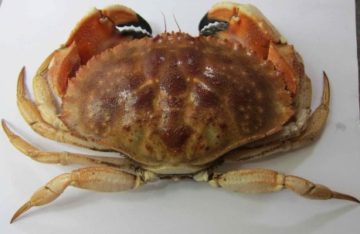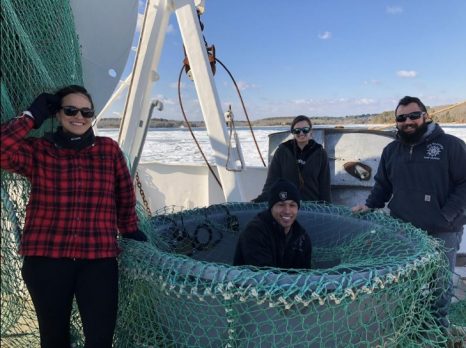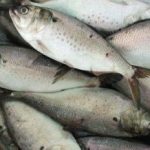Tag Archives: Gulf of Maine

Halving the number of vertical lines – Finding consensus on whale protections a tough call in Maine
Federal regulators have given Maine’s lobster industry its marching orders: Find a way to cut the number of surface-to-seabed fishing lines by 50 percent to help prevent the injury or death of even one of the endangered right whales that pass through the Gulf of Maine. The National Marine Fisheries Service is allowing each lobstering state to develop its own plan to protect the whale, whose numbers have fallen to a little more than 400 in recent years. But it will be hard to find one way to make it work in Maine, where the $485 million-a-year fishery is known for its diversity. >click to read<07:29

CLF OVERRULED! New Fishing Rights in Gulf of Maine Upheld by Judge
A federal judge upheld a rule Monday that opens up a portion of the western Gulf of Maine to commercial and recreational fishing for the first time. The Conservation Law Foundation had challenged the rule last year, claiming the National Marine Fisheries Service wrongly prioritized economic considerations over its conservation duty when it reduced the protected area in that portion of the Gulf by about 25%. While the rule offered habitat protection in the eastern Gulf of Maine for the first time, the conservation group said the agency and the New England Regional Council should have closed more of the Gulf to fishing. >click to read<17:28

Jonah Crab Moves Mainstream In Gulf Of Maine After Decades As Lobster Bycatch
Regulators are taking comments on plans to expand a lucrative new crab fishery that’s stirring interest in the Gulf of Maine. Jonah crabs are a native species that, until recently, was mainly caught as bycatch – by accident – in lobster pots.,,, New Hampshire Fish and Game biologist Josh Carloni says in Northern New England and the Gulf of Maine, lobster is still king – but that could change. >click to read<11:42

Record Lobster Production Defies Alarmist Climate Scare
Marine fisheries data show New England lobstermen are benefiting from a new golden age of lobster, thanks in large part to a warming Earth. Yet Democrats in Congress and even lobster lobbyists asserted in House climate hearings earlier in February that global warming is causing a lobster apocalypse. Thankfully, facts and scientific evidence can help us put this latest global warming scare to rest. On February 7, Democrats in the House Natural Resources Subcommittee on Water, Oceans, and Wildlife held hearings with the purpose of raising concern about global warming. >click to read<14:33
Subcommittee Hearing: Healthy Oceans and Healthy Economies: The State of Our Oceans In the 21st Century – Video, >click to watch<

ASMFC block Northern shrimp harvesting for 3 more years
Citing continuing concerns that further fishing could drive the species to extinction, the Atlantic States Marine Fisheries Commission voted Friday to cancel not only the 2019 Maine shrimp season, but the 2020 and 2021 seasons as well. Commissioners from New Hampshire and Massachusetts supported the closure, while Patrick Keliher, commissioner of the Maine Department of Marine Resources, voted no, according to Tina Berger of the commission. DMR spokesman Jeff Nichols said in an email that Keliher would have supported a one-year moratorium. >click to read<17:59

Ocean Shock: Lobster’s great migration sets up boom and bust
A lobster tattoo covers Drew Eaton’s left forearm, its pincers snapping at dock lines connecting it to the American flag on his upper arm. The tattoo is about three-quarters done, but the 27-year-old is too busy with his new boat to finish it.,,, Eaton belongs to a new generation of Maine lobstermen who are riding high, for now, on a sweet spot of climate change. Two generations ago, the entire New England coast had a thriving lobster industry. Today, lobster catches have collapsed in southern New England, and the only state with a significant harvest is north in Maine, where the seafood practically synonymous with the state has exploded. >click to read<11:54

Drastic cut to herring quota puts Maine lobstermen over the bait barrel
The New England Fishery Management Council voted last month to set the 2019 herring quota at 3.2 million pounds – about 78 million pounds less than what the East Coast herring fleet is permitted to catch this year – to help the population recover from a record-low number of juvenile herring. To put the cut in context, that is about 2,000 tractor-trailer trucks of the industry’s favorite bait that won’t be showing up in New England lobster ports next year. >click to read<06:58

Fishermen weathering effects of climate change
The lobster off western Cape Breton didn’t get the memo about thriving in colder water. “They should have told the lobsters that this year,” said John Phillip Rankin, a fisherman from Mabou Coal Mines. “By the first of July, it was warm and they started snapping but we were after putting our traps on the wharf. They start jumping when it gets warmer. They do all right in cold water. It was a decent season but it was cold-water trapping, you could tell. Last year, it was warm right through, a better season. The landings were quite a bit higher.” >click to read<14:35

NOAA findings on right whale endangerment could affect lobster fishery
A new report by the National Oceanic and Atmospheric Administration’s Northeast Fisheries Science Center finds that the decline of the North Atlantic right whale population over the past eight years is due to multiple factors that include entanglement with fishing gear. The whales’ range expansion has exposed them to vessel traffic and fisheries in Canadian waters, which did not have protections for right whales in place until late last summer, the report says. Lobster populations are also changing distribution in the Gulf of Maine, causing U.S. fisheries to move farther offshore in pursuit of lobsters, thus increasing overlap between fishing activity and right whale foraging areas and migration corridors. >click to read<14:30

Discovery of immature lobsters in deep Down East waters may be good news for industry
The discovery of baby lobsters in the deep waters off eastern Maine could be good news for the future of the U.S.’s most valuable fishery. Since 1989, scientists led by University of Maine professor Richard Wahle have looked for baby lobsters at 100 shallow-water test sites from Rhode Island to New Brunswick to monitor the health of this fishery. The number of babies found in the samples started to decline about a decade ago, leading scientists to worry that a population bust may be looming. “We couldn’t find the settlers,” Wahle said Monday. “Increasingly, we found they weren’t showing up where we had always found them.” >click to read<07:42

Decades of chemical pollution suspected in Maine’s seal die-off
As the number of dead and stranded seals washing up on southern Maine beaches rises by the day, researchers are linking the sudden die-off to decades of chemical pollution that made the seal population vulnerable to toxins and disease.,,, In the past week, volunteers responded to 100 dead seals on Maine beaches south of Portland and in Casco Bay, said Lynda Doughty, the group’s executive director. The phone has been ringing off the hook, and on Friday afternoon volunteers were clearing a backlog of animal reports. Rescuers reported 179 dead seals in Maine since the beginning of July and another 51 dead in New Hampshire, according to the agency>click to read<13:44

New England shrimp population still looks bad amid shutdown
A new analysis of New England’s shrimp population doesn’t bode well for the future of the long-shuttered fishery for the crustaceans. The Maine-based shrimp fishery has been shut down since 2013 because of concerns such as warming ocean temperatures and poor survival of young. Scientists working with the Atlantic States Marine Fisheries Commission are assessing the shrimp stock, and so far it looks like little has changed. Results of the stock assessment “look fairly similar to what we’ve seen in previous years,” said Megan Ware, a fishery management plan coordinator with the Atlantic States. >click to read<08:54

New England: Centuries-old cod fishery had worst year in history in 2017
One of the most historic fisheries in the country hit an all-time low last year as cod fishermen continued to struggle with choking quotas and low abundance of the fish. Maine’s cod fishery has existed since at least the early 17th century, and it was once one of the strongest in the country. The fishery peaked at more than 21 million pounds of cod, a fish often used with the fish and chips dish, in 1991.,,, One reason for the collapse is that federal quotas for cod are so low many fishermen are just avoiding them altogether, said Terry Alexander, a veteran fisherman out of Portland and Boston. Cod fishermen typically also seek other species, such as haddock and flounder, and they must stop fishing altogether once they reach quota for cod, per the rules. >click to read<11:15

Black sea bass surge off R.I.
Scientists tell us that some fish will be winners and others losers as oceans warm. In Rhode Island, count lobster, silver hake and winter flounder among the losers, their numbers plummeting as climate change drives water temperatures higher. On the list of winners so far are squid, summer flounder, butterfish. And black sea bass. The population of the dusky-colored fish with striking blue accents has historically been strongest off the mid-Atlantic Coast, but over the past decade or so its numbers have spiked off New England and it is becoming a more important catch for the region’s fishermen. How they are managed will have important implications not only for those fish but for lobsters and other key species in the ocean ecosystem. >click to read<12:30

The cost of herring – Fishermen feeling bait price squeeze
“We made no money this spring,” said Bass Harbor fisherman Justin Sprague. The cost of operations for lobstering continues to increase while the boat price of lobster has hardly budged. The cost of herring, the preferred bait for most Maine lobsterman, has gone up especially sharply. “We don’t have any margin at this point,” Sprague said. “It’s frustrating, to say the least.” Bruce Colbeth manages the C.H. Rich lobster wharf in Bass Harbor. “By the time these guys pay for fuel, bait and stern men, there ain’t too much left for them,” he said. “I remember six years ago you could sell (herring) bait for $26 a bushel. Now it’s doubled.” >click to read<11:41

For Maine lobstermen, conservation and success go hand in hand
It’s 7 a.m. on the Pull n’ Pray. The lobster boat rocks over large swells as the water sparkles in the June morning sun. The grating whirr of the hydraulic winch drowns out the hum of the boat’s motor as it lifts the first lobster trap of the day out of the water. Justin Papkee swings the trap up onto the side of his boat and quickly opens the latch. Suddenly there are lobsters flying through the air. Mr. Papkee’s blue rubber gloved hand is nearly a blur as he reaches again and again into the open trap, tossing the lobsters back into the water rapid-fire before pulling in the next trap. >click to read<12:28

How ropeless fishing traps could protect North Atlantic right whales — and the fishing industry
Tensions between Atlantic fishermen and conservationists escalated this week as the Department of Oceans and Fisheries closed six fishing grounds off the coasts of New Brunswick and Quebec.,, The whales’ arrival left many Canadian fishermen scrambling to remove their equipment from the affected waters amidst concern over what the closures could mean for their quotas. But scientist and veterinarian Michael Moore is advocating for a new technology that could appease both groups: ropeless fishing traps. >click to read<Who is Michael Moore, >click to read<09:52

Estimating similarity in benthic communities over decades and in areas open and closed to fishing in the central Gulf of Maine
ABSTRACT: The ledges and banks of the central Gulf of Maine (i.e. Fippennies Ledge, Jeffreys Ledge, Cashes Ledge, and Platts Bank) have supported groundfish and Atlantic sea scallop fisheries for centuries. The benthic community of Fippennies Ledge was evaluated and compared during 2 time periods separated by more than 2 decades, the first based on a series of photographs collected during manned submersible dives conducted in 1986 and 1987 and the second using photographs collected during drop camera video surveys conducted in 2009 to 2014. >click to read<21:08

Scientists say Maine’s lobster boom won’t last. Here are the fisheries coming next
In southern New England, many fishermen have turned their attention to species such as Jonah crab and black sea bass, the numbers of which have increased as ocean temperatures warm and as lobster in the region have become more scarce. Maine’s lobster landings remain near historic highs, but some say the changes that have occurred south of Cape Cod are inevitable in the Gulf of Maine. “I know it’s a hard concept to get around, but it’s going to happen,” Norbert Stamps, a Rhode Island fisherman, told a roomful of other fishermen at the Maine Fishermen’s Forum in Rockport in March. “It seems as the lobster declined [in southern New England], the crab increased. And sea bass are everywhere.” >click to read<10:43

Can anyone save the North Atlantic right whale? A group of South Shore lobstermen say they know what the answer is
By the time Mike Lane shoves off the Cohasset docks, it’s past 8 a.m. — practically lunch time for a lobsterman. But it’s early spring, and the South Shore fisheries are mostly closed, so Lane is keeping a somewhat relaxed schedule. Lobsters tend to hole up for the season several miles farther offshore, and Lane would like to be there, fishing his 800 traps. That area also happens to be a feeding area for North Atlantic right whales — one of our planet’s most endangered species. And so, four years ago, the federal government closed these grounds for much of the winter and spring. That means all Lane can do right now is set a few traps in a small area just outside Cohasset Harbor. >click to read<11:37

Lobster shell disease nudges up slightly off of Maine
A disease that disfigures lobsters has ticked up slightly in Maine in the last couple of years, but authorities and scientists say it’s not time to sound the alarm. The disease, often called epizootic shell disease, is a bacterial infection that makes lobsters impossible to sell as food, eating away at their shells and sometimes killing them. The Maine Department of Marine Resources said researchers found the disease in about 1 percent of lobsters last year. >click to read<16:41

New Research Shows ‘Strong Correlation’ Between Baby Lobster Decline, Possible Food Source
New science is bearing down on a poorly understood part of the North American lobster’s diet. And it turns out that a tiny crustacean’s abundance may help to explain expected declines in Maine’s lobster harvest. The Gulf of Maine brims with hundreds of varieties of transparent crustaceans known as copepods.,, Recently Record has put himself at the computational nexus of a handful of data sets that track a particular copepod in the Gulf of Maine, called Calanus finmarchicus. The clues to this connection can be found in the ocean waters off New Hampshire >click to read<11:41

Low numbers of endangered whales raise question about lobster industry impacts
Woods Hole Oceanographic Institution scientist Mark Baumgartner said that to help the whales survive much longer, the ropes Maine lobstermen use to tend their traps have to be modified or even eliminated. And it’s not just for the whales’ sake. “I feel the industry is in jeopardy,” Baumgartner said.,,, Last month the Conservation Law Foundation’s Portland office filed a federal lawsuit against the National Oceanic and Atmospheric Administration for violating the Endangered Species Act. >click to read< 12:10

What’s happening to the lobster babies? Portland dealer will pay to get an answer
Scientists want to know why the number of lobster babies in the Gulf of Maine is declining when their numbers at every other stage of their life cycle remain high. That question is considered so important to the future of Maine’s $1.5 billion lobster industry that one of Maine’s 200 lobster dealers – Ready Seafood of Portland – is funding a university study to investigate what some scientists call the big disconnect. “What’s happening to the babies?” asked Brendan Ready. >click to read< 14:18

Hitting the Trail: NOAA’s GARFO leader looks to cultivate culture of collaboration
As debuts go, Mike Pentony’s first day on the job as the regional director for NOAA’s Greater Atlantic Regional Fisheries Office was a corker. The federal government marked his ascension on Jan. 22 as only the federal government can — shutting down all but the most essential government services as a consequence of the usual congressional mumbley-peg. “My first action was to come in and proceed with the orderly shutdown of government operations,” Pentony said recently during an interview in the corner office on the uppermost floor of GARFO headquarters in Gloucester’s Blackburn Industrial Park. The respite was short-lived. The shutdown lasted a day. >click to read< 23:52

Don Cuddy – SMAST codfish counting innovation looks promising
Last December the New England Fishery Management Council voted to increase the amount of cod available to commercial fishermen in the Gulf of Maine by 39% for the 2018 fishing year. This is welcome news. New England fishermen have endured some lean years since 2013 when the cod quota was slashed by 78 percent after new data incorporated into the 2011 assessment indicated that the stock was lower than previously estimated-obviously a great deal lower. Estimating how many codfish might be out there at any given time is the greatest challenge facing fishery managers and the numbers have been subject of much controversy, with fishermen continually decrying the “best available science” as inadequate. >click to read< 19:25

Benchmark study of lobsters begins
In 2015, data collected in a benchmark assessment of New England lobster stocks showed record-high abundance for the combined stocks of the Gulf of Maine and Georges Bank and record lows for the lobster stock of southern New England. Now, about three years later, the Atlantic States Marine Fisheries Commission is beginning preparations for the next American lobster benchmark assessment that is expected to be completed around March 2020. “We’re in the very early stages right now,” said Jeff Kipp, senior stock assessment scientist at the Arlington, Virginia-based ASMFC that regulates the Northeast lobster fishery. “The process will be mostly data-driven.” >click to read< 21:10

Our View: Time for Maine to look past lobster boom years
There is an economic principle that’s usually attributed to Herbert Stein, who worked for the Nixon administration and The Wall Street Journal. Stein’s law: If something can’t keep going forever, it won’t. Maine’s lobster industry is near the peak of a historic boom, making it the state’s most lucrative fishery. In the last 30 years, lobster landings have increased from 20 million pounds a year to 130 million. No one expects the catch to keep growing forever. The question is not whether it will decline, but when. >click to read< 13:57
Gulf of Maine had cool year in 2017, but is still warming – >click to read<

Signs of more small shrimp good news – Research shrimper: Trawls better every week
There are days when Joe Jurek must feel the loneliness of the long-distance shrimper, a solitary figure in the Gulf of Maine as the only Massachusetts commercial fisherman allowed to harvest coveted northern shrimp from a fishery just entering its fifth year of closure. Jurek, a Gloucester-based groundfisherman and the captain of the 42-foot FV Mystique Lady,,, Jurek is the Massachusetts representative in a two-state research set-aside program and is doing most of his fishing in the inshore vicinity of Cape Ann, Ipswich Bay and nearby Scantum Basin. >click to read< 19:38 

State disputes study that predicts sharp decline in Gulf of Maine lobster population
The state agency that oversees Maine’s marine fisheries is questioning the reliability of a new study that predicts a sharp decline in Gulf of Maine lobsters over the next 30 years. The Gulf of Maine Research Institute, the University of Maine and the National Oceanic and Atmospheric Administration built a computer model that predicts the population will fall 40 to 62 percent by 2030. But Patrick Keliher, commissioner of the Department of Marine Resources, won’t be using the model to help him decide how to manage the state’s most valuable fishery,,, >click here to read< 01:06 














































